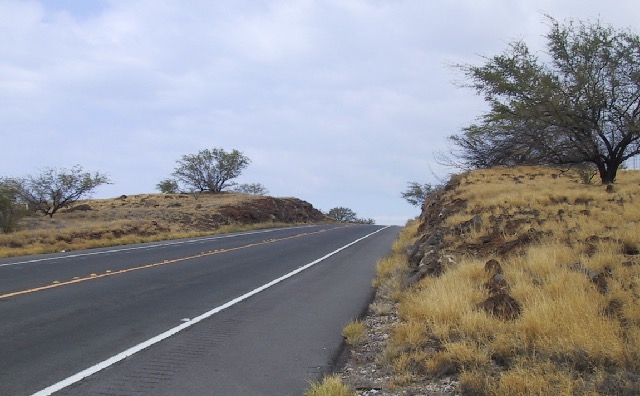The Big Island of Hawaii provides a twist on the old saw heard around the Midwest: “Don’t like the weather? Wait a minute, it’ll change.” Here, it’s “Don’t like the weather? Drive a few miles.” Or in our case, bike a little farther on. At any given moment along the 50-odd miles of the Ironman bike course, the wind may be blowing anywhere from 0 to 30 mph, from any direction of the compass. Clouds form randomly off the volcanos, and the temperature varies with elevation, usually in the range of 80 to the low 90s.
When the Ironman moved from Oahu to Hawaii in the early 80s, fewer than 100,000 people lived here. Now, that figure is nearly 200,000. Back then, there was basically Hilo, an old port in the southeast, and a scattering of old line plantation and ranch towns, like Waimea, Hawi, Kailua. These featured wooden homes and storefronts with rusting metal roofs, and a local population dependent primarily on the land (cattle, sugar, other agriculture) or the sea (fishing). Once Oahu became an urban metropolis, and Maui saw a tourist boom, more daring sun seekers found the Big Island. Retirees, ex-hippies, escapees from the “outer islands”, and visitors from the world over discovered the raw and open environment. Now, modern resorts have grown around the prime beaches, and permanent residents are starting to crowd the upcountry, basically between 1500 and 3000 foot elevation, where the air is a bit more temperate. Almost ideal, some would say. But a few pockets of the old Hawaii still exist, and Hawi is one of them.
Part of the reason is geography. The Northeast tip of the island sees a LOT of rain, falling on the slopes of the Kohala volcano, running back to the sea in a series of cavernous gulches, hundreds if not thousands of feet deep. It’s pretty much impossible to build any kind of road across this terrain, so Hawi is the hub for the End of the Road. The road continues a deteriorating 8 miles past the clapboard businesses lining the two blocks of the main road through town. Niuli’i sits out near the end of the road, but beyond that, it’s trails and wilderness.
So it’s kind of hard to get to Hawi, and harder to stay there. Situated at the Northern tip of the Island, this spot is rawly exposed to whatever winds are coming from the East. Filled with moisture from the ocean, the air slams into the mountain and is forced upward into cooler climes, where the water precipitates, often as fog, sometimes as drizzle or outright rain. Most days, Hawi sees sun and a breeze; others, it can be grey and wet. The wind is so reliably strong that the local airport boasts a modern windmill to generate power for the community.
In Ironman lore, the road to Hawi is noted as the only substantial climb on the course. In reality, the steady climb rises gently over 6 miles from 180 feet to a about 600, which works out to less than a 2% grade, never more than 4%. A piece of cake, in cycling terms; a big-ring climb. But: that road keeps turning right, angling through the wind. For the first 6-7 miles, there is almost always a powerful gusting side wind amidst rolling terrain, constantly up and down between 150 and 300 feet. Then, as the road shifts from a northwest to a northeast orientation, it starts aiming directly into a headwind, which can range from 10 to 30 mph on most days, sometimes associated with stinging fog. Then, the route makes a 180 in the middle of town, and riders get a free push back down the hill, first a pure tailwind, then a slamming sidewind as they head back down into the crucible of heat near the shore.
There are four environmental challenges which Ironman cyclists face on race day: Wind, sun, heat, and hills. The latter two are constant; you always know they will be there, where they will be, and how hot or steep the road will be. It is the sun and the wind which may vary. And both seem to reach their maximum on that climb to and descent from Hawi. For one thing, most middle of the pack riders are somewhere on that road at noon, when the sun in Hawaii is at its zenith. For another, the road is cut into the side of a hill, such that its rays are reflected back from the lava directly at the cyclist. Finally, at least until the final mile or two, there are NO clouds, and NO shade, just the relentless, beating sun.
And the wind. The best thing that can be said for it is the slight comfort it provides from the radiance of the sun. But it buffets and exhausts the riders who struggle against the gusts, fighting the direction changes as they move from gully to road cut and back again. Going back down, while not fighting a grade or headwind, can still be a tough slog to control a machine which wants to dance with the wind, while its rider wants to plough a steady row.
So, it’s not the climb to Hawi that makes it an epic station on the Hawaii Ironman pilgrimage. It is the sun and wind through which it traverses. Today was a fairly good day for me out there; I went 41 miles in 2 hours and 30 minutes, and only felt I was going to get blown over about 2 or three times. I could even keep myself (mostly) straight on (almost all of) the downhill.

